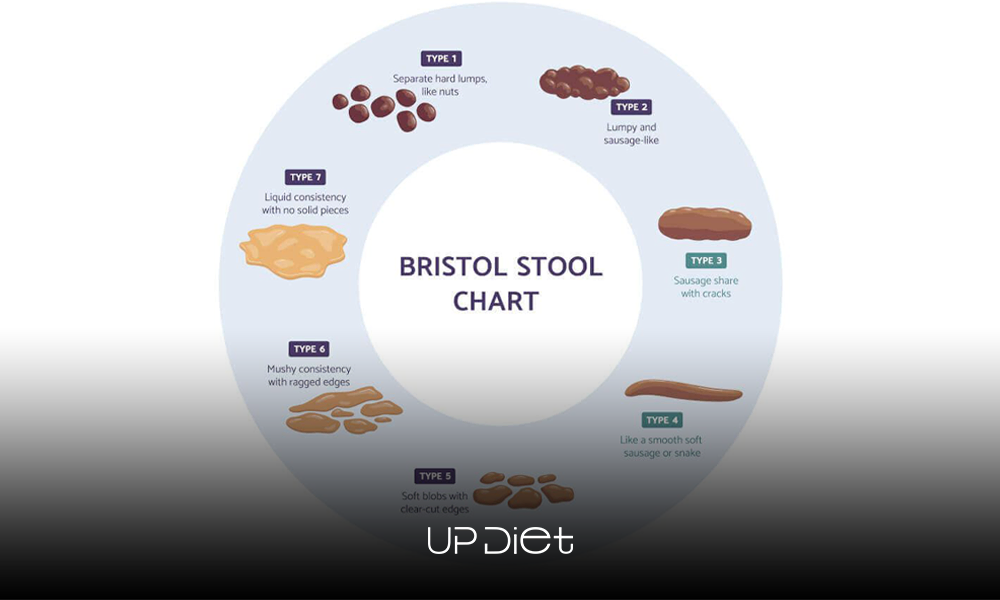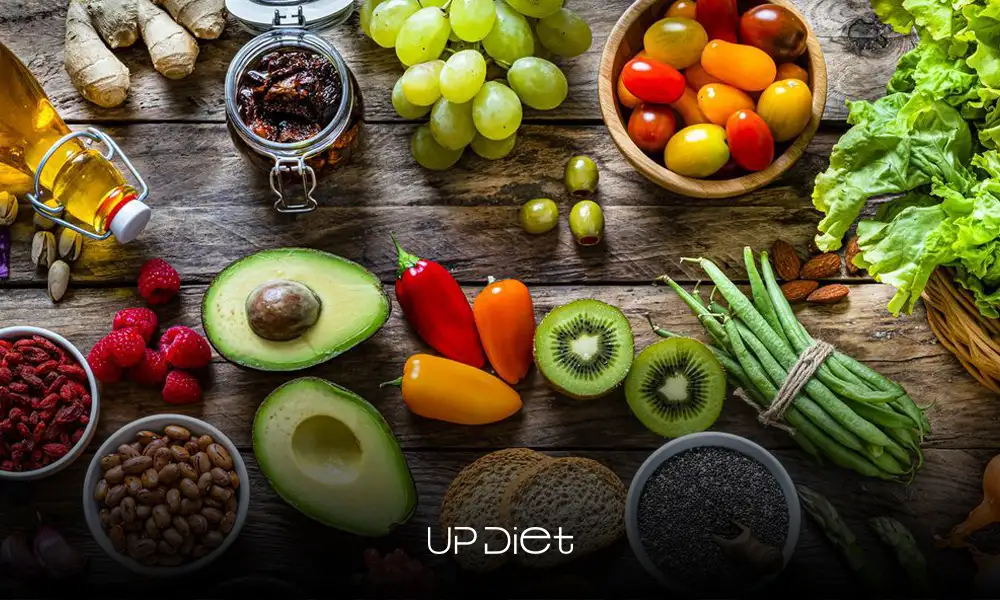Get a plan made for your unique body and goals
Your stool reveals a lot about you. In fact, all of your bowel habits (frequency, control, consistency, color) are strong indicators of how healthy your digestion is. That’s the idea behind a poop diet, using what your body eliminates as a guide to what it needs.
In this article, we’re going to understand what information your poop has, how you should build your poop diet around, and why fiber is such an essential part of this diet.
Understanding Constipation and What Your Poop Says About You
The Bristol Stool Chart categorizes stools into 7 types based on shape and consistency:
- Types 1 and 2 are considered constipation, dehydration, lack of fiber or magnesium, sluggish gut motility, or dysbiosis (gut microbiome imbalance), favoring methane-producing bacteria.
- Types 3 and 4 are healthy stool types. If it’s type 3, you’ll benefit from more water and soluble fiber. And if it’s type 4, congratulations! You have healthy digestion, because you’re probably drinking a lot of water and eating enough high fiber foods for constipation.
- Types 5, 6, and 7 indicate diarrhea. Type 5 may be due to high fiber intake (that you’re used to), stress, or a mild imbalance in gut flora. Type 6 may be because of gut inflammation, food intolerance, or overgrowth of harmful bacteria. And if things escalate from type 6 (or there’s an infection), you’ll experience type 7.
For more info about this chart, check out this article from Very Well Health.

Why Fiber Matters for Gut Health and Regularity
Fiber is getting more recognition as the unsung hero of soft stools and gut motility, but not all fibers work the same way:
- Soluble fiber absorbs water and forms a gel-like substance in your intestines. This softens your poop and makes it easier to pass. Soluble fiber also serves as (prebiotic) food for the beneficial bacteria in your gut.
- Insoluble fiber doesn’t dissolve; instead, it adds bulk to your poop and keeps things moving. That’s why they call it the gut’s broom, as it helps with regularity and prevents buildup that leads to constipation.
If you want to introduce all types of fiber into your day-to-day diet, you can choose a poop-based diet provider like UpDiet. They pinpoint what your gut needs to thrive and create meal plans based on your body and lifestyle.
Best High-Fiber Foods for Constipation Relief
Fiber-rich foods relieve constipation in multiple ways: they hydrate your body, they provide different types of fiber, and they stimulate the muscles of the colon for regular bowel movements.
Here’s a list of high fiber foods for constipation to maximize these benefits:
- Fruits: especially berries (strawberries, raspberries, blackberries), apples, pears, prunes.
- Vegetables: broccoli, carrots, brussels sprouts, cauliflower, green beans.
- Legumes: beans, lentils, chickpeas.
- Whole grains: oats, quinoa, brown rice, barley, whole wheat.
- Seeds: flaxseed, chia seeds.

The Poop Diet: Eating According to Your Stool Type
Eating high fiber foods is great, but you need to understand what your stool is telling you. This helps fine-tune your diet to restore perfect balance.
- Hard, pebble-like stool means that it’s stayed in the colon for too long and lost its water. You need to increase soluble and insoluble fiber intake, drink water consistently, add healthy fats to lubricate your digestive tract, and eat laxative fruits.
- If you have dry, crumbly stool, then your water intake isn’t enough (even if you’re eating fiber). Drink plain water with electrolytes or herbal teas, eat water-rich foods, and add more soluble fiber to your diet.
- If you have smooth, soft stool, keep the rhythm. Stay active and hydrated, too, and don’t forget to support your microbiome with probiotic foods.
- Loose, mushy stool means the food is moving too quickly, so the body can’t absorb its nutrients and water. To fix this, add sources of soluble fiber, and eat fermented foods along with gentle, whole foods. Don’t forget about fluids and electrolytes, too (coconut water, soups, broths).
- Watery stools or frequent diarrhea mean your gut is inflamed or reacting to something (infection, intolerance, severe dysbiosis). Follow a bland, binding diet temporarily, reintroduce probiotics, replace lost electrolytes, and avoid irritants until your gut is stable.
- If you’re experiencing irregular stool, your gut microbiome or motility is out of sync. This is mostly due to IBS or stress, and you can fix it by adding probiotics and prebiotics, eating high fiber foods for constipation consistently, hydrating evenly, and avoiding large/heavy portions or skipping meals.

Habits That Support Healthy Digestion
- Stay hydrated. Water is essential for every stage of digestion, from breaking food down to softening stool. Aim for 2-3 liters of water daily and include water-rich foods.
- Move your body every day. Regular exercise literally helps move your bowels (it stimulates intestinal muscles). It also reduces bloating and gas.
- Manage stress. Chronic stress alters microbiome balance and triggers constipation or diarrhea. Give deep breathing, mindfulness, journaling, or meditation a try.
- Eat regular, balanced meals. Irregular eating patterns confuse your digestive system and microbiome. Eat every 3 to 5 hours (mindfully, without distraction) and balance meals with protein, healthy fats, and fiber.
- Practice healthy bathroom habits. Go when you feel the urge, but don’t rush or strain. It’s also a good idea to use a footstool to align your colon naturally.
Final Thoughts: Listen to Your Gut (and Poop)
Your stool may be your body’s waste, but it’s also feedback and data. If you pay attention to it, you’ll spot early signs of imbalance before discomfort comes. Over time, those small adjustments in fiber, hydration, and lifestyle turn into long-term digestive health.
- In this post:
- Understanding Constipation and What Your Poop Says About You
- Why Fiber Matters for Gut Health and Regularity
- Best High-Fiber Foods for Constipation Relief
- The Poop Diet: Eating According to Your Stool Type
- Habits That Support Healthy Digestion
- Final Thoughts: Listen to Your Gut (and Poop)




